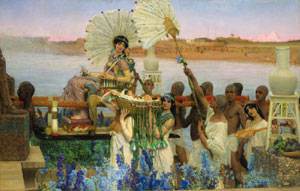
Sir Lawrence Alma-Tadema
The Finding of Moses
Masterpiece by Sir Lawrence Alma-Tadema, sold for $36 million ‘The Finding of Moses’, a 19th century masterpiece by Sir Lawrence Alma-Tadema, sold for a remarkable $35,922,500, more than seven times the presale high estimate of $5 million, at Sotheby’s New York]]>
November 6th 2010, source: Sotheby’s
The monumental canvas was sought-after by three determined bidders who battled fornearly eight minutes. Soon after auctioneer and Vice Chairman Benjamin Doller opened the bidding on thespectacular painting, it quickly rose to more than $20 million in a battle between two clients participating byphone. Suddenly, a new bidder in the room entered the fray, raising a paddle for $23.5 million. After severalmore minutes the painting sold to one of the original phone bidders for an extraordinary $35.9 million, a newrecord for the artist at auction. The previous record for the artist had in fact been set by this exact paintingwhen it was sold in 1995 for $2.8 million. The painting was included in a sale of 19th Century European Artwhich brought a total of $61,536,125.
The Finding of Moses stands as one of Sir Lawrence Alma-Tadema’s greatest masterpieces. In November1902, the artist left London to travel to Egypt for the opening of the Aswan Dam as a guest of Sir John Aird,the renowned engineer and head of the project. In his personal life, Aird was known as a great patron of the arts,and he likely brought Alma-Tadema on this trip to commission another painting from the artist for hiscollection. Alma-Tadema in turn found himself as inspired by Egypt as he had been 50 years earlier in histravels to Pompeii. He provided Aird with three subject options, from which he quickly chose The Finding ofMoses.
The painting once belonged to Allen Funt, creator of the popular prank show Candid Camera. His collection ofmasterworks by Alma-Tadema was exhibited in a landmark show at the Metropolitan Museum of Art in 1973. Ifthe setting of The Finding of Moses looks familiar, it is because prints of the painting were later used by CecilB. DeMille’s script writers and designers as inspiration for scenes from Cleopatra (1934) and The TenCommandments (1956).
Follow us on:


